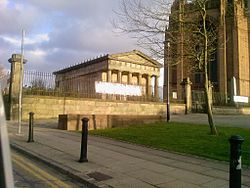The Oratory, Liverpool facts for kids
Quick facts for kids The Oratory |
|
|---|---|

The Oratory
|
|
| Location | Liverpool, England |
| OS grid reference | SJ 354 895 |
| Built | 1829 |
| Architect | John Foster |
| Architectural style(s) | Greek Revival |
| Governing body | National Museums Liverpool |
|
Listed Building – Grade I
|
|
| Designated | 28 June 1952 |
| Reference no. | 1063282 |
| Lua error in Module:Location_map at line 420: attempt to index field 'wikibase' (a nil value). | |
The Oratory is a special building located near the Liverpool Anglican Cathedral in Merseyside, England. It was once a chapel used for funeral services at the nearby St James Cemetery. Today, it holds a cool collection of sculptures and important memorials from the 1800s. These artworks are part of the Walker Art Gallery. The Oratory is considered a very important historical building, known as a Grade I listed building in England.
The Oratory's Story
The Oratory was built way back in 1829. It was used for funeral services before people were buried in the cemetery next door. A talented architect named John Foster designed it.
After the cemetery closed, the building wasn't used anymore for a while. Then, in 1986, National Museums Liverpool took care of it. Now, it's a home for many beautiful sculptures and statues.
What Does The Oratory Look Like?
The building is designed to look like an ancient Greek temple, specifically in a style called Doric. At each end, there's a porch with six tall columns, which is called a portico.
You won't find any windows in the Oratory! Instead, light comes in from above, making the inside feel unique. Inside, the ceiling has a cool patterned design, called a coffered ceiling, supported by Ionic columns. Many experts think this is one of John Foster's best buildings still standing.
On June 28, 1952, the Oratory was officially named a Grade I listed building. This means it's a very important part of England's history and architecture. It's even described as one of the "purest monuments" of the Greek Revival style in England. Around the Oratory, you can see old cast iron railings and gate posts, which are also protected as Grade II listed structures.
Amazing Art Collection
Inside the Oratory, you'll find many amazing monuments and sculptures. Most of these are Neoclassical reliefs, which are artworks carved into flat surfaces. Many of these pieces were moved here in the 1980s from other buildings that were being taken down.
Some of the famous artworks include:
- A monument from 1834 by Francis Leggatt Chantrey for the Nicholson family.
- A sculpture by John Gibson for William Earle, who passed away in 1839.
- A piece by J. A. P. Macbride for Dr William Stevenson, from 1853.
- Another work by Gibson for William Hammerton, from 1832.
- A sculpture by Joseph Gott for William Ewart, from 1823.
- A piece by Gibson for Emily Robinson, from 1829.
- A monument by Pietro Tenerani for Agnes Jones, from 1868.
There's also a statue of William Huskisson by Gibson, which used to be in the Custom House.
See Also
- Grade I listed buildings in Liverpool
- List of public art in Liverpool
- Architecture of Liverpool

